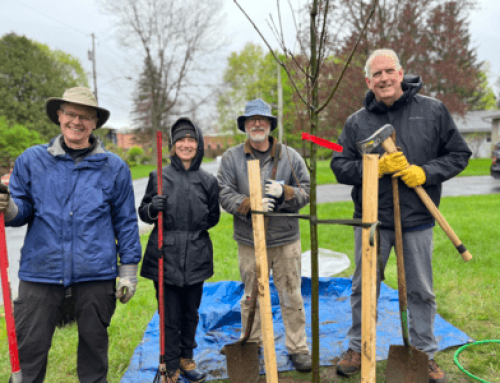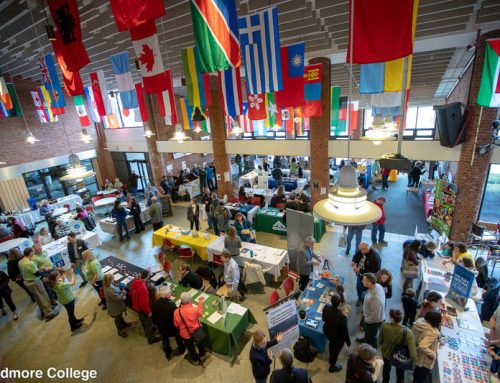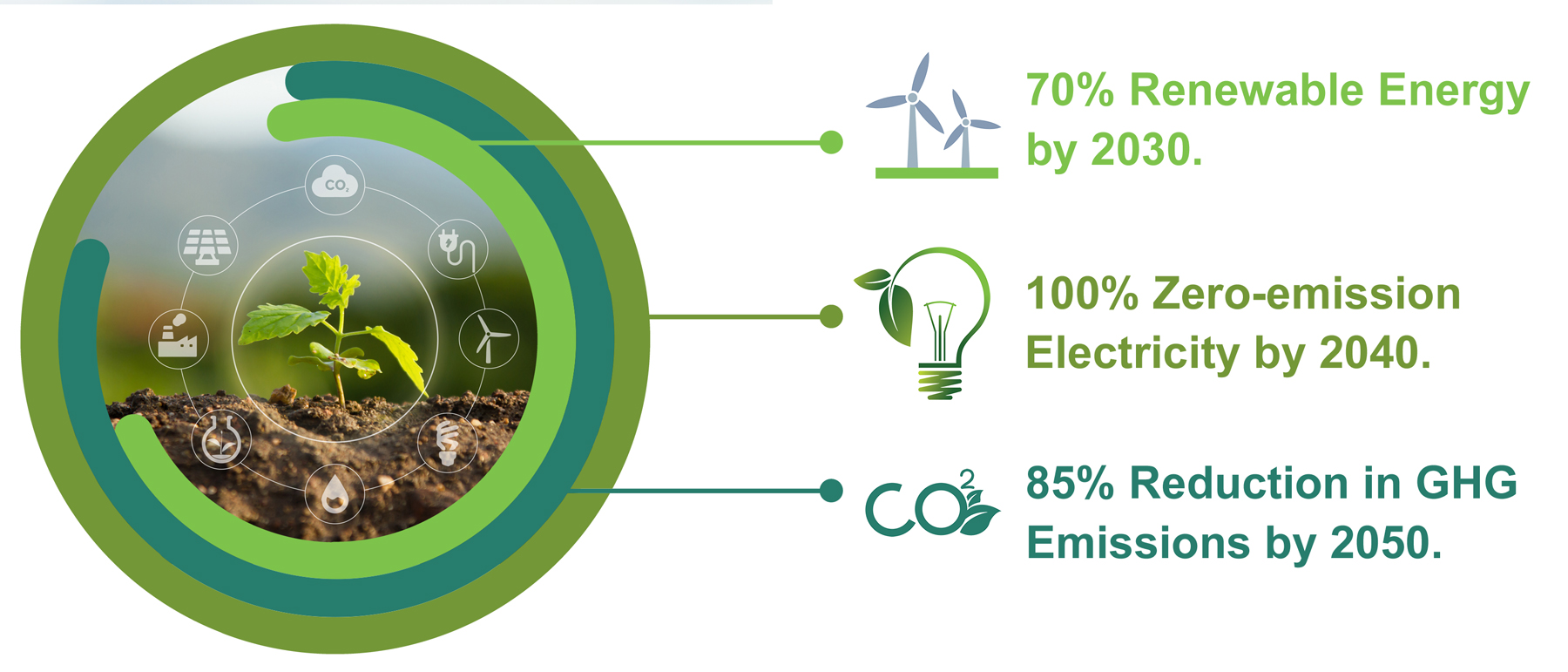
The Climate Leadership and Community Protection Act (CLCPA, or the Climate Act) was signed into law in 2019 as one of the most ambitious climate laws to date, requiring reductions in statewide GHG emissions of 40% by 2030 and 85% by 2050 (compared to 1990 baseline levels of GHG emissions). The final 15% of emissions will be offset through carbon sequestration practices such as planting trees, forest and wetland preservation, and land management, many of which are currently underway here in Saratoga Springs. The end result will be net zero emissions.
The law also created the Climate Action Council, which is tasked with developing a draft scoping plan for how the State will reduce greenhouse gas emissions and achieve net-zero emissions, increase renewable energy usage, and ensure climate justice.
On December 20, 2021, their Draft Scoping Plan was released, and January 1, 2022 marks the beginning of a public comment period to receive feedback from the public. The comment period is open until June 10, 2022. The overarching goal of the Council is to have a final draft scoping plan by the end of 2022. It is also important to note that the CLCPA is a product of years of advocacy work from a plethora of environmentally focused community organizations.
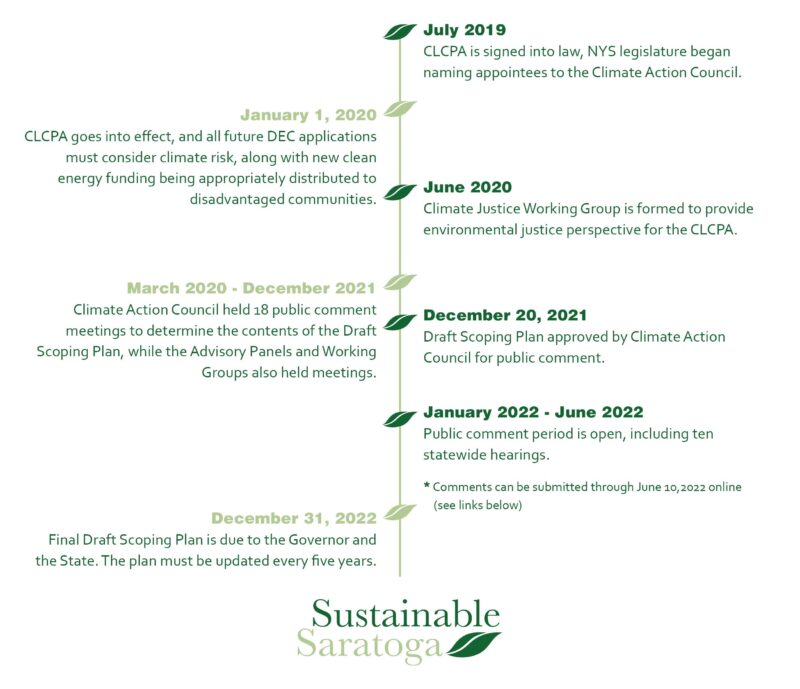
*Public comment period is open, including ten statewide hearings.
Comments can be submitted through June 10, 2022 online here.
Climate Act Goals – Fast Facts & Numbers:
- 6,000 MW of distributed solar by 2025
- 40% reduction in emissions by 2030
- 70% renewable electricity by 2030
- 3,000 MW of energy storage by 2030
- 9,000 MW of offshore wind by 2035
- 100% zero-carbon electricity by 2040
- Net Zero emissions by 2050
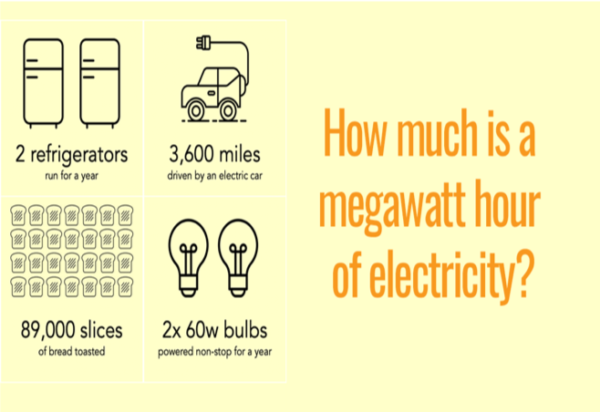
Image: https://www.freeingenergy.com/what-is-a-megawatt-hour-of-electricity-and-what-can-you-do-with-it/
How will the NY CLCPA be successfully executed?
The New York State Climate Action Council, along with the Climate Justice Working Group and other consultants, are preparing the Final Scoping Plan, a plan which lays out how we will achieve the State’s targets in regard to the Climate Act.
The New York State Climate Action Council is a 22-member committee that is preparing the Scoping Plan (the Draft Scoping Plan is available here). The Council is working in consultation with seven sector-specific advisory panels and two justice-focused working groups to prepare specific recommendations to the Council regarding the State’s sustainability, resiliency, and equity goals. (NYC Office of Climate and Sustainability). The Climate Action Council must complete the Final Scoping Plan by January 1, 2023, which will then be updated every five years.
The Climate Justice Working Group
The Climate Justice Working Group is comprised of people from various environmental justice communities within New York State, including members from New York City, rural communities, and upstate New York, as well as representatives from the State Departments of Environmental Conservation, Health, Labor, and NYSERDA.
The Climate Justice Working Group has an important advisory role in the Climate Action Council process, providing strategic advice for incorporating the needs of disadvantaged communities in the Scoping Plan. The Working Group will ensure that while the state moves towards a carbon neutral economy, all New Yorkers will experience equitable benefits.
All groups involved in the creation of the Draft Scoping Plan are crucial to ensure the impacts of the CLCPA are equitable and fair, along with being realistic and including the public in an extremely important piece of legislation. For more context to both groups and their roles, click here or visit the CLCPA webpage.
Goals of the Draft Scoping Plan
- Consider climate justice, job creation, cost reductions, public health benefits, and minimizing emission leakage (a concept which refers to the movement of businesses and industry out of state to locations without similar GHG emissions reductions laws, thus undermining the effort to address climate due to moving the point of emissions to other places).
- Address upstream emissions associated with fossil fuels from out-of-state
- Undertake comprehensive benefit-cost analysis
- Seek public feedback on the mix of strategies and level of ambition
- Inform New Yorkers about the NYS Climate Act
Goals of the CLCPA
- Specific emission targets by sector
- By 2030, New York aims to get 70% its electricity from renewable sources
- By 2040 the goal is to have all the state’s electricity come from carbon-free sources
- This will involve changes to heating systems, transportation, and other types of infrastructure
- Climate Justice provisions
- No less than 35% of the plan’s benefits should be directed towards historically disadvantaged communities (Climate.ny.gov)
- “Community air monitoring program” to monitor air pollution on a community level
- Focus on equality of impact and ensuring all New Yorkers benefit from more sustainable laws and practices
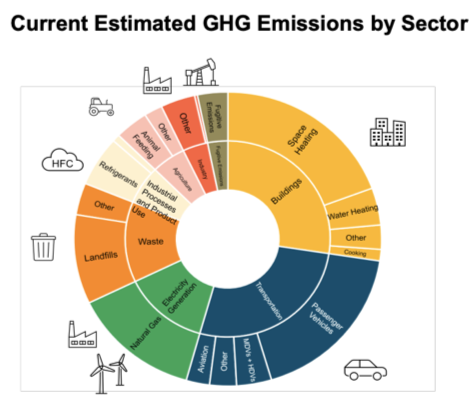
Existing progress and changes to expect by sector
ENERGY: There will be nearly 100 new solar and wind projects by 2030 which will add approximately 11,000 megawatts to the NY power grid, enough to power over 5 million homes in New York State. The goal is to reach 70% renewable energy by 2030 and 100% zero emissions electricity by 2040 (Climate.ny.gov). These goals will be reached through a combination of currently operating renewable energy sources, contracted renewables, and expected future contributions and projects.

Image: https://climate.ny.gov/Our-Progress
TRANSMISSION: Transmission lines carry energy from its point of generation into homes and businesses. Traditionally, these lines are connected to fossil fuel sources, but renewable energy from solar and wind can also be transported by transmission lines (click here for more info). New York State is currently in the process of building new green transmission lines, with 250 miles already under construction (Climate.ny.gov). This will aide in the transition to renewables as New York’s primary energy source.
BUILDING ELECTRIFICATION: New York State is also investing approximately $6.8 billion in energy efficient buildings and clean heating through 2025. Building decarbonization is also an important aid in increasing efficiency of our structures, which you can read more about on our Green Building webpage. Programs increasing energy efficiency and training workers in the energy sector will eventually lead to a reduction of 3 million metric tons of carbon pollution, which is equivalent to 600,000 cars being removed from the road (Climate.ny.gov). Additionally, there is the New York State Clean Heating Program, which provides a variety of new heating pump technologies, workforce training, community engagement, and a roadmap to how New Yorkers can more efficiently heat their homes and learn about new renewable energy sources (Climate.ny.gov). HeatSmart Capital Region is also a fantastic resource; HeatSmart “helps Capital Region residents explore ways to improve how they heat and cool their buildings” with the help of funding from New York state.
TRANSPORTATION: New York state has invested $1 billion in New York’s transportation sector, with the hope of making electric vehicles both more available and more accessible. There is also the goal of reducing carbon emissions and increasing clean transit in low income and disadvantaged areas (Climate.ny.gov). The state has an EV-Make Ready program, which provides over $701 million through 2025 to incentivize charging station developers to create more charging stations. Approximately a third of this funding will be allocated to ensuring disadvantaged communities have equal access. There are a plethora of existing projects, including NYSERDA’s ChargeNY program, which are working towards multiplying the number of EV charging stations in New York State. Additionally, more than 37,000 Drive Clean Rebates have been used by New Yorkers to aid in their purchase of electric vehicles (Climate.ny.gov). According to NYSERDA, the rebate works by giving a discount on electric vehicles purchased after June 30th, 2021.

Image: https://www.nyserda.ny.gov/All-Programs/Drive-Clean-Rebate/How-it-Works
For more resources on why owning an electric vehicle is important and how to utilize the Drive Clean Rebates program NYS is offering, see here:
What to expect moving forward:
The CLCPA’s impact on your life as a New York State resident:
In the coming decades, there will be a great deal of change in New York. Our energy sources will change, our communities will look different, and we will be moving towards a greener and more responsible future. In regards to changes on an individual scale, your energy sources will switch to renewable if they are not already. There will be a greater focus on sustainability, and conscientiousness in relation to the future. There are many things you can do to aid this transition and get started now, such as looking into purchasing an electric vehicle, changing your energy sourcing, and many other small changes. Sustainable Saratoga’s website has some resources to help you manage this transition.

Public comment period is open, including ten statewide hearings.
Comments can be submitted through June 10th 2022 online here.
Summary
To conclude, the goals outlined within both the Draft Scoping Plan and the CLCPA are concise, responsible, and a definite step in the right direction for both New York and the precedent it will set. The Act has great potential to inspire action by other states, emphasizes the importance of uplifting marginalized groups, and provides a clear and feasible timeline of what is to come in the near future. As we move into our future, our health and safety will be better protected as New York works towards a greener future through the CLCPA.
Sustainable Saratoga promotes sustainable practices and the protection of natural resources through education, advocacy and action. We provide educational resources that people can use to make informed decisions that affect everyday life, advocate for sustainable policies and programs, and empower our community to take action.
Please consider making a donation today. Your gift supports community events like Tree Toga, Repair Café, and Saratoga Recycles Day, educational events like our composting resources, and supports our advocacy to protect open spaces and address the climate crisis. You can help make our community a more sustainable place for current and future generations to enjoy. Leave a lasting legacy for future generations by donating today.




